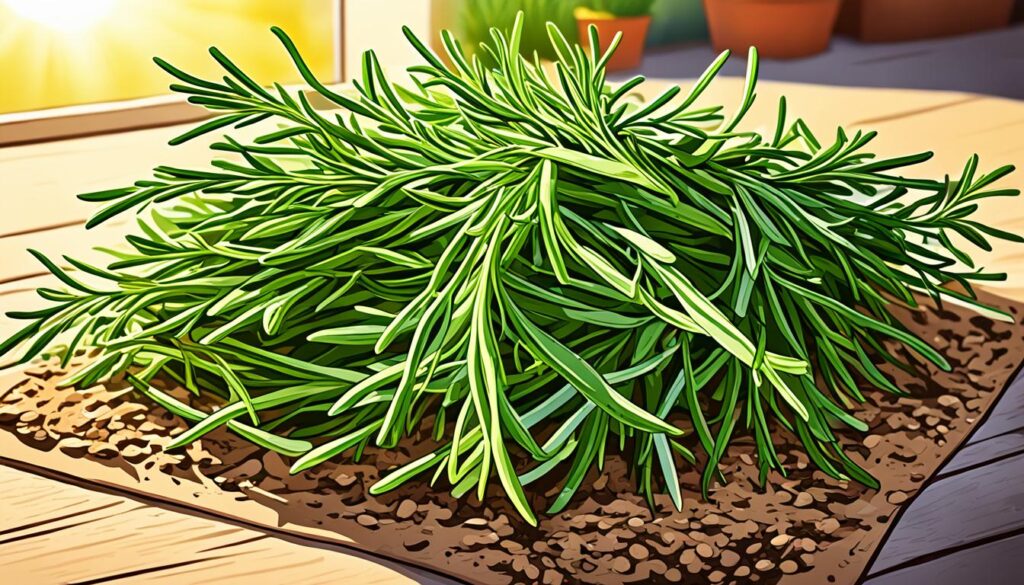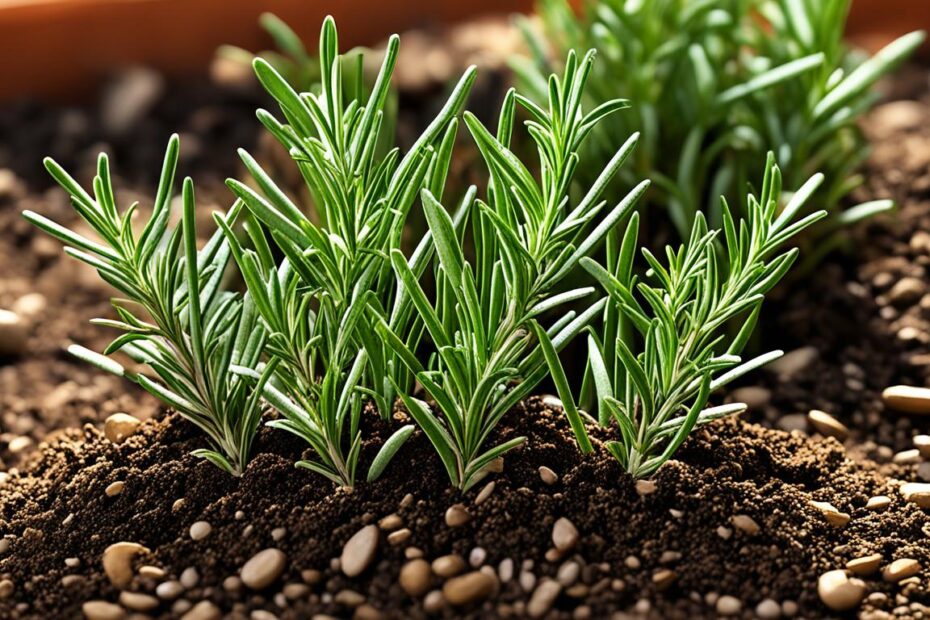Are you looking to add a vibrant and aromatic herb to your garden? Have you ever wondered how to grow rosemary from cuttings in soil? If so, you’re in the right place! In this article, we will guide you through the simple steps of propagating rosemary, so you can enjoy a thriving herb garden filled with the fragrance of this versatile herb.
Whether you’re a seasoned gardener or a beginner, propagating rosemary from cuttings in soil is an easy and rewarding process. By following our expert tips and techniques, you can successfully grow new rosemary plants and enhance your culinary creations with freshly picked sprigs of this fragrant herb.
Key Takeaways:
- Propagating rosemary from cuttings in soil is a simple and reliable method for growing new plants.
- Rosemary is a valuable asset to any garden, with its low maintenance and hardiness.
- The best time to propagate rosemary cuttings is in late spring to early summer, when the plant is actively growing.
- Using the right tools and techniques, such as stripping leaves and applying rooting hormone, can increase the success rate of rosemary propagation.
- There are two methods of rooting rosemary cuttings: water propagation and soil propagation, each with its own benefits.
Why Choose Rosemary Cuttings
Rosemary is not only a popular culinary spice but also a valuable asset to the garden. It offers numerous benefits that make it an ideal choice for any garden enthusiast.
Hardy Herb
Rosemary is a hardy herb that can withstand various growing conditions. It is drought-tolerant, meaning it can thrive in dry climates or soil conditions. This resilience makes it a reliable choice, even for gardeners who may not have a green thumb. Whether you live in a hot, arid region or have limited time to devote to your garden, rosemary is a plant that will withstand the test of time.
Low Maintenance
For those seeking a low maintenance garden, rosemary is the perfect choice. It requires minimal care and attention to thrive. Once established, rosemary plants are relatively self-sufficient, needing only occasional watering and light pruning to maintain their shape and size. This low-maintenance nature frees up your time and energy for other gardening tasks.
Companion Plant
Rosemary is not just a beautiful herb, it is also an excellent companion plant. Companion planting involves pairing plants that benefit each other when grown in close proximity. Rosemary acts as a companion to many plants, warding off pests and insects, such as cabbage moths and carrot flies. It also provides shade to smaller, sun-sensitive plants in the garden, creating a harmonious and mutually beneficial ecosystem.
Pollinator-Friendly
Another advantage of growing rosemary is its ability to attract pollinators. The plant produces stunning blue flowers that bees and other pollinators are irresistibly drawn to. By adding rosemary to your garden, you are not only enhancing its aesthetic appeal but also encouraging biodiversity and supporting the essential work of pollinators in the ecosystem.

When to Propagate Rosemary Cuttings
To ensure successful propagation of rosemary cuttings, it is essential to choose the best time to take your cuttings. Late spring to early summer is the ideal season for propagating rosemary from cuttings. During this period, the plant is in its active growth phase, producing fresh and vigorous new growth.
When selecting cuttings, it is important to remember that softwood cuttings work best for beginners. These cuttings are taken from the new growth of the plant, which is flexible and green. Softwood cuttings root more quickly and have a higher success rate compared to older, woody stems.
To identify suitable softwood cuttings, look for stems that are pliable and have not yet developed thick, woody tissues. These soft stems are more receptive to rooting and will produce new plants with ease.
In summary, the best time to propagate rosemary from cuttings is in late spring to early summer when the plant is actively growing. Opting for softwood cuttings ensures a higher success rate for beginners, as they root quickly and effortlessly.

Benefits of Propagating Rosemary Cuttings
“By propagating rosemary cuttings during late spring to early summer, you’re taking advantage of the plant’s optimal growth period. Softwood cuttings ensure a higher success rate for beginners, giving you the satisfaction of growing your very own rosemary plants.”
How to Propagate Rosemary Cuttings
Propagating rosemary cuttings requires a few essential tools. You will need sharp pruners or scissors to make clean cuts, a sharp knife for preparing the stem, a diluted bleach solution for sanitizing your tools, filtered water, glass or plastic jars for rooting, and rooting hormone as an optional supplement.
Before making any cuts, it is crucial to sanitize your tools to prevent the introduction of pathogens. This can be done by soaking your pruners, scissors, and knife in a diluted bleach solution. This simple step will help ensure the health and success of your cuttings.
Next, select a mature and healthy rosemary plant for taking cuttings. Look for a plant that has strong growth and shows no signs of disease or stress.
When taking the cuttings, strip the lower leaves from the stem layer to expose more surface area for rooting. This will also help prevent the leaves from rotting once placed in water or soil.
Using a sharp knife, make a clean cut at a 45-degree angle just below a leaf node. This angle provides a larger surface area for rooting and encourages better water absorption.
If desired, you can dip the cut end of the rosemary cutting into rooting hormone. This optional step can help stimulate root growth and increase the success rate.
Once your cuttings are ready, place them in a jar filled with filtered water or a pot with well-draining soil. Ensure that the leaves are above the water or soil level to prevent rotting.
Tool Checklist for Propagating Rosemary Cuttings:
- Sharp pruners or scissors
- Sharp knife
- Diluted bleach solution for sanitizing tools
- Filtered water
- Glass or plastic jars
- Rooting hormone (optional)
With the right tools and techniques, you can successfully propagate rosemary cuttings and enjoy a bountiful herb garden filled with the aromatic and flavorful herb.
Two Methods of Rooting Rosemary Cuttings
When it comes to propagating rosemary, there are two methods that you can choose from: rooting in water and rooting in soil. Both methods have their benefits and can lead to successful propagation of your rosemary cuttings.
Rooting in Water
If you’re new to propagating plants, rooting rosemary cuttings in water is a great option to start with. It is a beginner-friendly method that requires minimal equipment and provides fast root growth. Here’s how you can do it:
- Select a healthy rosemary cutting with several leaf nodes.
- Fill a glass or jar with water and remove the lower leaves from the cutting.
- Place the cutting in the water, ensuring that the nodes are fully submerged.
- Change the water every few days to prevent rot and maintain oxygen levels.
- After a few weeks, you should start seeing roots forming.
- Once the roots are well-developed, transfer the cutting to a pot with well-draining soil.
Rooting rosemary cuttings in water allows you to witness the root development firsthand, making it an exciting process for beginner gardeners.
Rooting in Soil
If you prefer a method that leads to stronger root growth, rooting rosemary cuttings in soil is the way to go. This method mimics the plant’s natural growth conditions and encourages robust root formation. Here’s how you can do it:
- Select a healthy rosemary cutting with several leaf nodes.
- Remove the lower leaves from the cutting, leaving about two sets of leaves at the top.
- Moisten a well-draining potting mix and fill a small pot or container with it.
- Create a hole in the soil using a pencil or your finger.
- Insert the cutting into the hole, ensuring that at least one node is below the soil surface.
- Gently press the soil around the cutting to secure it in place.
- Water the cutting thoroughly and place it in a warm and bright location.
- In a few weeks, new leaves should start to emerge, indicating successful root growth.
Rooting rosemary cuttings in soil provides a stable and nutrient-rich environment for the roots to develop, leading to healthier and more resilient plants.
Comparison Table: Water Propagation vs. Soil Propagation
| Method | Root Growth | Observation |
|---|---|---|
| Water Propagation | Faster | Root development visible |
| Soil Propagation | Stronger | New leaves indicate root growth |
Conclusion
Propagating rosemary from cuttings in soil is a simple and rewarding process. By following the proper techniques and using the right tools, you can successfully grow new rosemary plants. Whether you choose water propagation or soil propagation, you can enjoy the benefits of a flourishing herb garden with lush rosemary plants. Happy gardening!
FAQ
Can I propagate rosemary from cuttings in soil?
Yes, propagating rosemary from cuttings in soil is a simple and rewarding process.
When is the best time to propagate rosemary cuttings?
The best time to propagate rosemary from cuttings is in late spring to early summer, when the plant is actively growing.
What tools do I need for propagating rosemary cuttings?
You will need sharp pruners or scissors, a sharp knife, diluted bleach solution for sanitizing tools, filtered water, glass or plastic jars, and rooting hormone as an optional supplement.
How do I sanitize my tools before propagating rosemary cuttings?
It is important to sanitize your tools before making any cuts to prevent the introduction of pathogens. You can use a diluted bleach solution to sanitize your pruners, scissors, and knife.
What type of cuttings should I use for propagating rosemary?
Softwood cuttings are recommended for beginners as they root more quickly and have a higher success rate. Softwood cuttings are taken from the new growth of the plant and should not have thick, woody stems.
Can I use rooting hormone for propagating rosemary cuttings?
Using rooting hormone can increase the success rate of rooting rosemary cuttings.
What are the two methods for rooting rosemary cuttings?
The two methods for rooting rosemary cuttings are water propagation and soil propagation.
Which method is more beginner-friendly for rooting rosemary cuttings?
Water propagation is the most beginner-friendly method for rooting rosemary cuttings.
What are the benefits of water propagation for rosemary cuttings?
Water propagation results in faster root growth and allows you to see the roots developing.
What are the benefits of soil propagation for rosemary cuttings?
Soil propagation tends to produce stronger root growth and may show new leaves as an indication of root growth.
